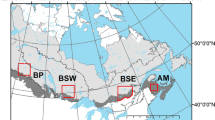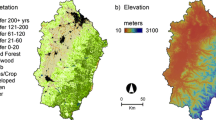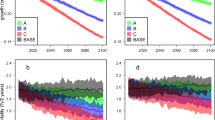Abstract
Changes in seasonal temperature and precipitation, as predicted by several global climate models, were utilized together with a stochastic daily weather stimulation model to evaluate the ecological impacts of projected global climate change scenarios on temperate forest ecosystems in northern Michigan, USA. The model simulated the impacts of these projected changes on ecologically significant weather variables, such as the length of the frost-free period, average growing season temperature, average growing season degree days (4.4° C basis), summer precipitation, potential evaporation during the growing season, and the ratio of precipitation to potential evaporation during July and August. The results indicate that even the lower range of predicted climate changes could lead to ecologically and commercially significant changes in the composition and productivity of these forests. Of particular concern is the possibility of climatically induced regional decline episodes for a number of important commercial species in the northern temperate forests of central North America.
Similar content being viewed by others
References
Albert DA, Denton SR, Barnes BV (1986) Regional landscape ecosystems of Michigan. School of Natural Resources, University of Michigan, Ann Arbor
Benzie JW (1977) Manager's handbook for red pine in the northcentral states. USDA, Forest Service, General Technical Report NC-33
Benzie JW (1982) Red pine. In: Mroz GD, Berner J (eds) Artificial regeneration of conifers in the upper Great Lakes region. Michigan Technological University, Houghton, pp 134–141
Botkin DB, Nisbet RA, Reynales TE (1989) The effects of climate change on the forests of the Great Lakes states. Bull Ecol Soc Amer 69:77
Carter KK (1991) Provenance tests as indicators of tree growth response to climate change. In: Emerging issues in northern hardwood management: air pollution, climate change, and biodiversity. Ford Forestry Center, Michigan Technological University, Houghton. Misc Publ 91-1:40
Davis MG (1989) Insights from paleoecology on global change. Bull Ecol Soc Amer 70:222–228
Desanker PV, Reed DD (1991) A stochastic model for simulating daily growing season weather variables for input into ecological models. In: Proceedings of the 1991 Systems Analysis in Forest Resources Symposium, Charleston, S.C., pp 1–10
Dunne T, Leopold LB (1978) Water in environmental planning. W.H. Freeman, New York
Eamus D, Jarvis PG (1989) The direct effects of increase in the global atmospheric CO2 concentration on natural and commercial temperate trees and forests. Adv Ecol Res 19:1–55
Fuller LG, Reed DD, Holmes MJ (1987) Modeling northern hardwood diameter growth using weekly climatic factors in northern Michigan. In: Proceedings of the IUFRO Conference on Forest Growth Modeling and Prediction, Vol I. University of Minnesota, St. Paul pp 467–474
Gates DM, Strain BR, Weber JW (1983) Ecophysiological effects of changing atmospheric CO2 concentration. In: Lange OL, Nobel PS, Osmond CB, Zeigler H (eds) Physiological plant ecology IV. Ecosystem processes: Mineral cycling, productivity, and man's influence. Springer-Verlag, Berlin, pp 503–526
Hepting GH (1971) Diseases of forest and shade trees of the United States. USDA, Agricultural Handbook No. 386. US Government Printing Office, Washington, DC
Holdaway MR, Brand GJ (1985) Identifying climatic variation in growth model errors. In: Influences on tree and stand increment. Maine Agricultural Experiment Station, University of Maine, Bangor. Misc. Publ. No. 631:98–107
Intergovernmental Panel on Climate Change (1990) Scientific assessment of climate change. World Meteorological Organization, United Nations Environment Programme, Geneva, Switzerland
Jones EA, Reed DD, Cattelino PJ, Mroz GD (1991) Seasonal shoot growth of planted red pine predicted from air temperature degree days and soil water potential. Forest Ecol Managm 46:201–214
Karl TR, Heim RH Jr, Quayle RG (1991) The greenhouse effect in central North America: if not now, when? Science 251:1058–1061
Kim E, Siccama TG (1987) The influence of temperature and soil moisture on the radial growth of northern hardwood tree species at Hubbard Brook Experimental Forest, New Hampshire, USA. In: Proceedings on the International Symposium on Ecological Aspects of Tree-Ring Analysis, Marymount College, Tarrytown, New York. US Department of Energy, No CONF-8608144, pp 26–37
Liechty HO, Holmes MJ, Reed DD, Mroz GD (1991) Changes in microclimate after stand conversion in two northern hardwood stands. Forest Ecol Managm (in press)
Manabe S, Wetherald R (1986) Reduction in summer soil wetness induced by an increase in atmospheric carbon dioxide. Science 232:626–628
Merz RW (1978) Forest atlas of the Midwest. USDA, Forest Service, North Central and Northeastern Forest Experiment Stations, College of Forestry, University of Minnesota, St. Paul
Millers ID, Shriner DS, Rizzo D (1989) History of hardwood decline in the eastern United States. USDA, Forest Service, General Technical Report NE-126
Mroz GD, et al (1990) Annual report of the herbaceous plant cover and tree studies. In: Compilation of the 1989 Annual Reports of the Navy ELF Communications Ecological Monitoring Program, Vol I. Illinois Institute of Technology Research Institute. Technical Report No. E06620-4, pp 1–275
Norby RJ, O'Neill EG, Luxmore RJ (1986) Effects of atmospheric CO2 enrichment on the growth and mineral nutrition ofQuercus alba seedlings in nutrient poor soil. Plant Physiol 82:83–89
Overpeck JT, Bartlein PJ, Webb T III (1991) Potential magnitude of future vegetation change in eastern North America: comparisons with the past. Science 254:692–695
Perala DA (1985) Predicting red pine shoot growth using growing degree days. Forest Sci 31:913–925
Plantico MS, Karl TR, Kukla G, Gavin J (1990) Is recent climate change across the United States related to rising levels of anthropogenic greenhouse gases? J Geophys Res 95:16617–16637
Reed DD, Holmes MJ, Jones EA, Liechty HO, Mroz GD (1990) An ecological growth model for four northern hardwood species in Upper Michigan. In: Process modeling of forest growth response to environmental stress. Timber Press, Portland, Ore, pp 288–293
Reed DD, Jones EA, Liechty HO, Mroz GD, Jurgensen MF (1992) Impacts of annual weather conditions on forest productivity: a case study involving four North American deciduous tree species. Int J Biometeorol (in press)
Schneider SH (1989) The greenhouse effect: science and policy. Science 243:771–781
Solomon AM, Bartlein PJ (1991) Past and future climate change: response by mixed-deciduous coniferous forest ecosystems in northern Michigan. Can J Forest Res (in press)
Solomon AM, West DC (1987) Simulating forest responses to expected climate change in eastern North America: applications to decision-making in the forest industry. In: The greenhouse effect, climate change, and US forests. The Conservation Foundation, Washington, DC, pp 189–207
Thornwaite CW, Mather JR (1955) The water balance: laboratory of climatology, Pub No 8, Centerton, NJ
USDA Agricultural Research Service (1990) USDA plant hardiness zone map. Miscellaneous Publication No 1475. US Government Printing Office, Washington, DC
USDA Soil Conservation Service (1975) Soil taxonomy. USDA, Agricultural Handbook 436. US Government Printing Office, Washington, DC
Zhang YF, Reed DD, Cattelino PJ, Gale MR, Jones EA, Liechty HO, Mroz GD (1991) A process-based growth model for young red pine. Forest Ecol Managm (in press)
Author information
Authors and Affiliations
Rights and permissions
About this article
Cite this article
Reed, D.D., Desanker, P.V. Ecological implications of projected climate change scenarios in forest ecosystems in northern Michigan, USA. Int J Biometeorol 36, 99–107 (1992). https://doi.org/10.1007/BF01208920
Received:
Revised:
Accepted:
Issue Date:
DOI: https://doi.org/10.1007/BF01208920




